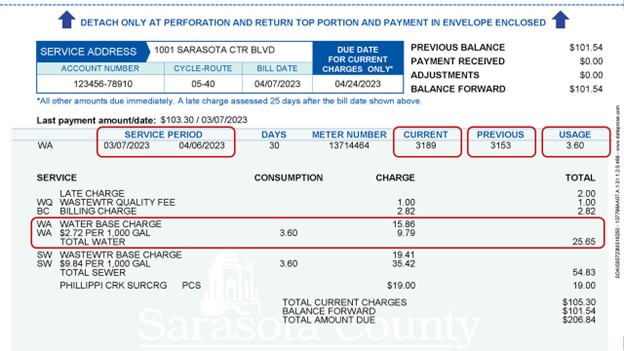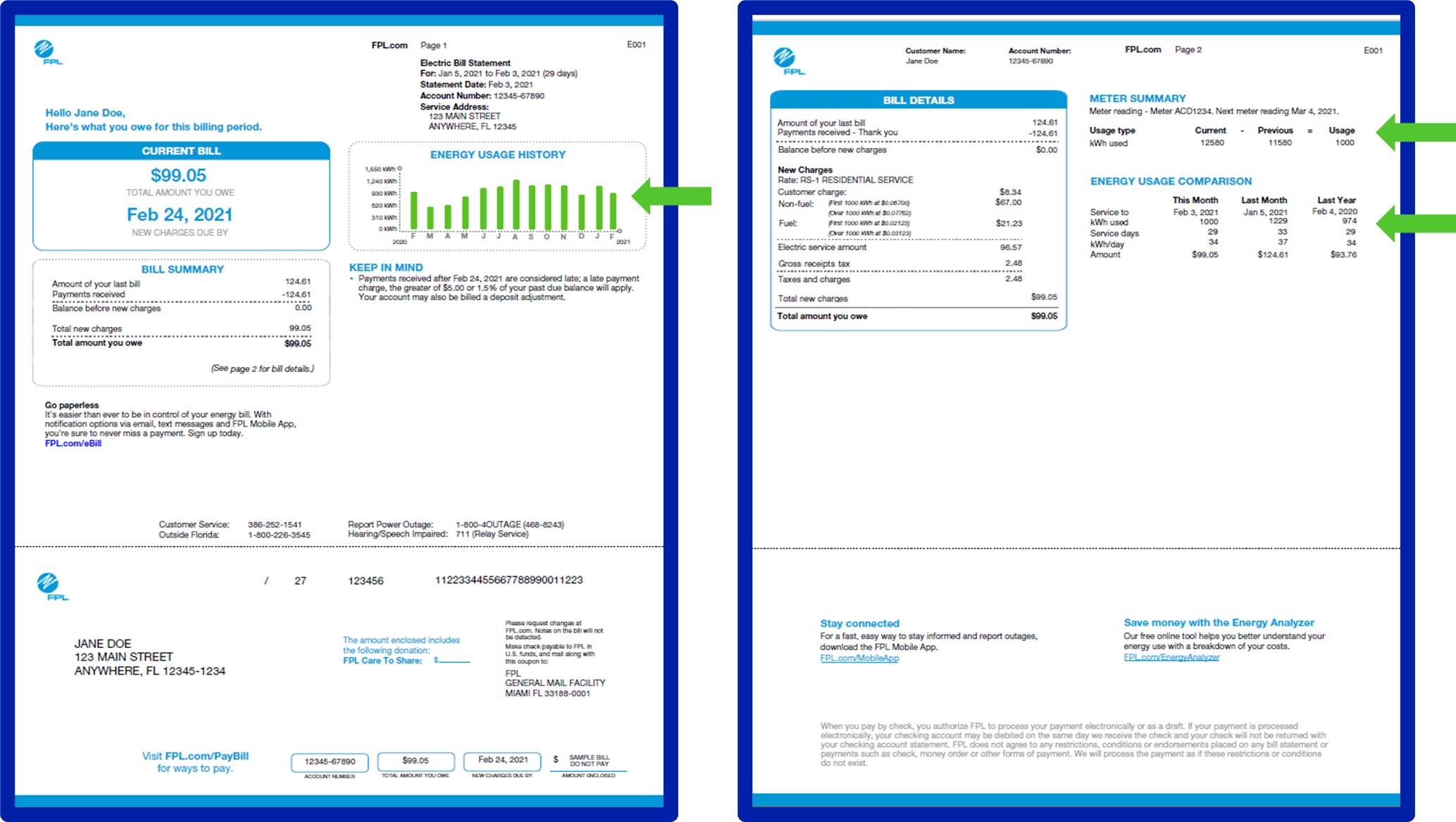Introduction
Whether you’re new to the area or have lived here for years, chances are you’ve used electricity or water in your home. If this is the case, you may have also received a bill in the mail (or your email). It can be tricky to read and understand your bills, and when they’re unusually high, it may not always be obvious why. In this blog, we will break down your bills and show you ways you can save money by reducing your energy and water use at home.
Reading Your Water Bill
It’s important to pay attention to our water bills, so we can keep track of our water use over time. It’s not just about saving money but also saving a precious and limited resource, especially for generations to come.
Keeping an eye on your water use throughout the year can help you notice important changes over time. It can help you determine how much water and money you’re saving as well as give you a heads up if there may be a leak or other issue wasting water on a larger scale on your property.
How much does the typical Sarasota County resident use? Well, about 80 gallons per individual and 158 gallons per household, on average.
Here is an example water bill for a Sarasota County Utilities customer. If you receive your bill from another county or municipality, it may look slightly different.

Here you can see the portion of the bill that shows your water use and charges by line. These bills have a 30-day cycle, or service period. Utilities will look at the water meter readings from your current and last cycles and subtract the difference. That ends up being marked as your “usage” for the current cycle.
There are two charges directly associated with your potable water use, tagged “WA.”
First is your base charge, which is the flat fee Utilities charge everyone for the base costs of providing water. This includes the electricity needed to transport and clean the water, any associated personnel, other costs of daily maintenance of the delivery system, and other fixed operating costs (EPA). After that is the usage charge, which is $2.72 for every 1,000 gallons used during that cycle. You might notice that the usage number looks a little “off.” Well, that’s because it needs to be multiplied by 1,000 to get your true gallons used.
If you multiply the number under “usage” by $2.72, then you get $9.79! Add that to your base charge ($15.86) for a total of $25.65 spent on water for this cycle.
Reading Your Electric Bill
Your electric bill can look complex at first glance, but it contains a lot of information that explains why you’re being charged what you are. Let’s look at the electric bill below from Florida Power & Light (FPL), the main electric utility provider for Sarasota County, to explain in more detail.

The image on the left represents the front of an electric bill from FPL. The front of the bill will list your charges for the current period and due date for payment in the blue box titled “Current Bill”. Also on the front side of your FPL bill, you will notice the “Energy Usage History” bar graph, which will show a visual representation of your energy usage each month for the past year.
The image on the right represents the back of your electric bill. The back side of your bill includes more of the details behind your charges and how these charges compare to previous billing periods. The box titled “Bill Details” will explain and break down each charge that goes into your electric bill total – including fuel/transportation costs, taxes, and the rate at which your electric usage is billed. It’s always a good idea to check this section of your electric bill regularly, especially if you are curious about what other charges you are paying for each month. Other sections to look out for on the back side of your electric bill include the “Meter Summary”, which details the specific amount of electricity consumed that billing cycle in kilowatts (kWh), and the “Energy Usage Comparison”, which compares your energy use and charges from this month to last month and last year.
Your electric bills are also available to view online if you are an FPL customer. The Florida Power & Light dashboard offers even more insight into your electric bills, how your charges have changed over time, and even where they think your electricity is being used. Check if you have an online FPL account and see where you can save even more by visiting FPL’s online Energy Manager tool here: https://www.fpl.com/landing/energy-manager.html
Saving Water Indoors
Besides irrigation, we also have several water wasters in the home. The biggest offender is our toilets, which are estimated to use 24% of our potable water, but we also must be conscious of our showers, sinks, and clothes washers. Of all these numbers, though, one that we absolutely have to work on is leaks. Leaks are responsible for an estimated 12% of water used in the home per year. That is water that is being wasted and potentially leading to damage in the home.
When it comes to saving water indoors, these quick tips can make a big difference if done consistently. These are mostly easy behaviors that you can pick up and use
to save a lot of water and money over time.
- Take shorter showers instead of taking a bath.
- Install a water efficient toilet.
- Turn off the water when you’re brushing your teeth or shaving.
- Plug the sink when washing dishes by hand and reuse that water elsewhere (i.e. watering plants)
- Only run the dishwasher or washing machine when you have a full load.
- Get water leaks fixed.
By following these tips, you can save hundreds, if not thousands, of gallons of water every year. If you want to learn more about what you can do to save water at home, visit our website: tiny.cc/ufsaraext_savewater.
Saving Energy
Due to Florida’s hot and humid climate, households in the Sunshine State use more energy for air-conditioning than any other appliance or end-use in the home – nearly 40% of our electric bills are attributed to A/C usage. Here are some strategies you can use at home to lower your electric bill and make sure your air-conditioner is working efficiently:

- Clean or replace air filters monthly
- Set your thermostat to a different temperature when you’re at home, compared to when you’re away
- Use ceiling fans whenever and wherever possible – but don’t forget to clean the fan blades and turn them off when leaving a room!
To maximize your energy and water efficiency at home, be sure to look for WaterSense and EnergyStar products when available. Products with these designations are the most water- and/or energy-efficient models available in the market, which also means they will cost less to run over time. Some examples of how these products can cut your utility costs include:
- Installing WaterSense showerheads and faucet aerators – uses less water than non-WaterSense models (2,000 less gallons a year!) and saves energy by reducing demand for hot water
- Switching to an EnergyStar water heater – newer water heaters use less energy to heat your water quicker, which reduces overall water use (and incentives are available to help you purchase one!)
- Replacing your clothes washer and/or dryer – front-loading machines are more water- and energy-efficient, on average, compared to top-loading machines (EnergyStar laundry machines are also sales tax-exempt in Florida until July 2024!)
 3
3
